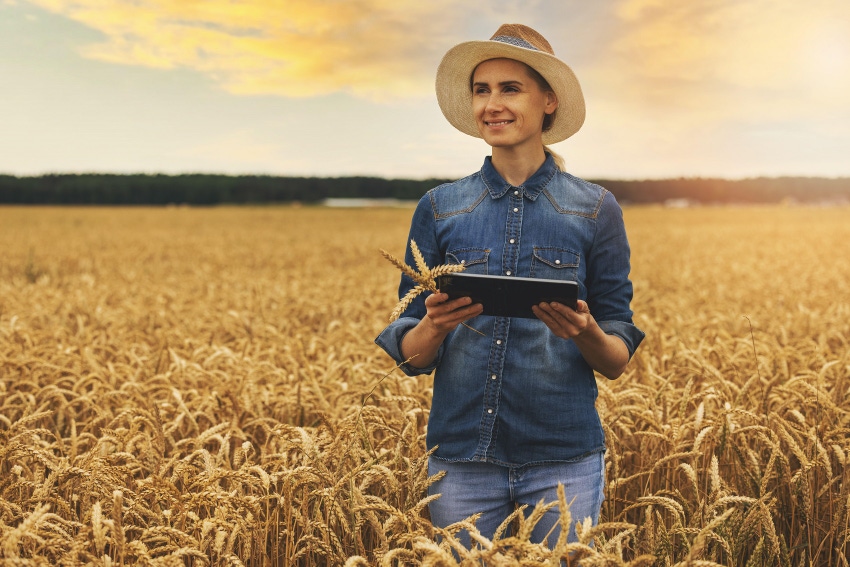Farming in the Digital Age
Modern technologies, including imaging, autonomous vehicles and machine learning are combining to bring efficiency and greater production to today’s farming sector.

As the global population grows and drastic shifts in weather continue, farmers face a critical challenge: ensuring humanity remains fed, fueled, and clothed. Historically, agriculture has required loads of manual labor and a deep connection to the land and seasons. While the connection to the land remains, technology is ushering in a new era of farming.
Food doesn’t just appear in the grocery store. Farmers around the world work day after day to plant, nurture and grow the food that ends up on our plates. Like the seasons, farming is cyclical, and it focuses on four main jobs: preparing the land, planting the seeds, nourishing the plants, and harvesting the crops. These tasks have not changed since the dawn of farming. But what’s different in today’s world is how technology amplifies the work farmers do and provides a secret weapon to overcome the challenges they face.
There are a number of companies that are focused on bringing advanced technology to agriculture because it serves a real and vital purpose for the growing population, which is expected to reach 10 billion by 2050.
Digital Groundwork
Before a single seed is placed into the ground, many farmers will first get the soil ready during a process called tillage. This requires farmers to turn, stir, and break up the soil so the ground is ready for seeds -- and it’s typically an arduous and long process. Many farmers rely on their accumulated experience and techniques passed down through generations to determine the best ways to till and nurture the soil.
But, with the advent of autonomy and GPS, the act of preparing the land has become a blend of tradition and tech. Machines can navigate and steer themselves through vast fields with remarkable precision. It also optimizes every inch of land and maximizes potential crop yield. Not only does this save farmers time and effort, but it also ensures a more consistent and efficient use of their resources.
Seeds and Software
The act of planting seeds may seem straightforward, but there’s a science to it. The spacing of planted seeds influences their chances of growth. Robotic metering in the large machines that put seeds in the ground ensures precise seed placement to enhance plant growth. It takes one second for today’s planters to put up to 100 seeds into the ground at the right depth and the right distance from one another. Metering allows farmers to plant at a faster rate and move through the field at a higher speed. This gets the job done sooner and with the precision necessary for successful plant growth.
In some cases, when seeds enter the ground, a farmer might also want to include fertilizer. In the past, that fertilizer was sprayed continuously down each row of seeds. Modern farming harnesses robotics, sensors, and automation in a symphony of precision. As each seed is placed into the soil, these technologies work in congruency to spray the exact amount of fertilizer required for optimal growth. Fertilizer hits the seed directly and only with what’s needed: roughly the amount that could fit on the head of a pin. This precision reduces the amount of starter fertilizer farmers need to use by 60%. Considering that application of fertilizers in crop production accounts for 27% of greenhouse gas emission from food production, the impact of reduced usage cannot be overstated. Through this precision, farmers ensure their soil is healthy for the next generation.
Data-Driven Ascension
Once the seeds are in the ground, they must grow into healthy plants. Weeds and pests work against this, so farmers often turn to herbicides to help. In the past, the broad use of herbicides meant that, while they were effective in managing weeds, the spraying wasn’t exclusively targeted at them.
Computer vision and machine learning are ushering in a revolution in weed management. These technologies provide newfound observations and intelligence about the fields, allowing for a much more nuanced approach to crop-care. Sprayers are able to capture detailed images of crops and weeds. As images stream from the cameras, processors evaluate every image. A plethora of cameras attached to a typical 120-foot sprayer boom can scan more than 2,200 square feet of land and capture 1.2 billion pixels per second. To put this speed into perspective, think about reading. The average person reads at a speed of about 200 to 250 words per minute. In the time it would take you to read one word of this article, these sprayers would have processed upwards of 1,000 images. Using advanced technologies in the spraying process also cuts total herbicide use by two-thirds.
Harvesting with High-Tech Precision
Harvest is the climax of the agricultural cycle. It’s the moment of truth that determines the success of a season’s efforts. During a harvest, it’s not uncommon for farmers to work 18-hour days. Modern-day harvesting is more refined than ever before due to technological strides in the form of cameras equipped with computer vision and automation.
At harvest, farmers can use automated combines -- large agricultural machines akin to factories on wheels – to traverse the field. The combine separates the grains and kernels from each plant. It’s a task completed at a massive scale as streams of grain flow directly into the tank to hold the materials. Farmers often struggle during this step because they can’t see the quality of all the grain or what’s happening inside the machines. This means they could potentially harvest a 50-acre field before realizing something is amiss.
Cameras enabled with computer vision make it possible for the machine to “see” the condition of the grains and kernels that land in the tank, and automatically adjust the combine settings. Doing so allows for constant monitoring of the quality and condition of every harvested kernel.
The Cycle Continues
In farming, the end of one season is the beginning of the next. As farmers collect the last of the harvest, they are already looking to the future and preparing for the next planting season.
Their commitment to their land, crops, and by extension, the global community is unwavering. And technology has become an indispensable ally in the farmer’s journey. It allows for continuous learning and adaptation -- the feedback from one season is integrated into the plans for the next.
Farmers not only produce our food and clothes, they caretake our land. It’s this harmonious blend of age-old farming wisdom matched with cutting-edge technology that will lead the industry forward amidst unparalleled global challenges.
Read more about:
Digital BusinessAbout the Author(s)
You May Also Like







